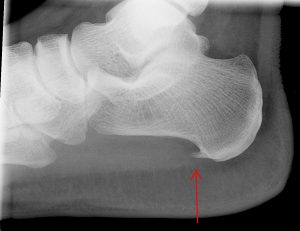If you are experiencing some kind of foot pain, you will need to narrow down what the condition might be so that you can treat it effectively.
Most people wrongly assume that if the pain is in the heel, or base of their foot, then they must have Plantar Fasciitis.
Whilst this may be quite likely, it is important to look at all the facts before coming to that conclusion.
There are 3 conditions that quite often get wrongly diagnosed as Platar Fasciitis.
- Heel Spur
- Plantar Fascia Major Tear,
- Plantar Fascia Rupture.
All 3 of these conditions exhibit similar symptoms, however there are some crucial differences between them.
Depending on the actual cause of your foot pain, you could be doing more damage than good, if you apply the wrong treatment method, due to a wrong diagnosis.
This guide should help you narrow down what may be the cause your foot pain.
What Is Plantar Fasciitis?
Plantar Fasciitis is where the plantar fascia tissue that runs along the base of the foot has become damaged with minute tears. These tears become inflammed and cause discomfort and pain.
Plantar Fasciitis starts off more as a discomfort in the base of the foot, rather than pain.
The most common area for this discomfort is in the heel or ball of the foot behind the toes. These areas are most affected due to them being the anchor points of the plantar fascia that connects the heel bone to the toes to create an arch in the foot.
Plantar fasciitis pain is usually felt first thing in the morning when weight is added to the foot for the first time of the day, or after a period of rest.
As you sleep, or rest for a while, the minute tears in the plantar fascia begin to heal. As you stand up again and apply weight to the foot, those tears are split open again, causing the pain.
Due to the small size of the tears, the pain is usually only mild at this stage.
If you do not take action to repair the damage to the plantar fascia, your condition will get worse over time and the level of damage will increase, as will the level of pain you will feel each time you stand.
If the damage becomes significant, then you take the risk of suffering from a major tear.
Related Article: Will My Plantar Fasciitis Go Away On Its Own?

What Is A Plantar Fascia Major Tear
A major tear is when your plantar fascia has been badly torn, but has not quite ruptured. Imagine a rubber band that has started to split but not broken in half. This can occur when the plantar fascia has been weakend due to ongoing untreated plantar fasciitis, or has been placed under greater strain due to weight or sports.
If you are suffering with a major tear, the pain will be quite significant and you will be finding it difficult to put weight onto the damaged foot.
If you have been suffering from plantar fasciitis, and it has now developed into a major tear due to inaction on your part, NOW really is your last chance to act before you are laid up with a rupture.
At this point, you can still go about your daily life, albeit at a slower pace with lots of rest inbetween.
You will probably want to think about wearing a walking boot (Available at Amazon) to protect the plantar fascia from further damage.
With rest and icing your foot, you should be able to let nature repair the damage without too much trouble. Following the R.I.C.E method will get you on your way.

Related Article: Breaking the Continuous Cylce of Plantar Fasciitis Pain
What Is A Plantar Fascia Rupture?
When the Plantar Fascia completely snaps, it is known as a rupture. This can happen when the weakened plantar fascia is placed under considerable sudden strain by jumping or running. The rupture will make it almost impossible for the person to apply any weight to the foot.

When you suffer with a plantar fascia rupture, the pain will be intense and immobility will be immediate.
Many athletes and people who partake in high impact sports suffer with ruptures and have said that there was a kind of ‘popping’ sensation in their foot at the time of the rupture.
The treatment for a rupture usually involves a period of total rest for a couple of weeks, followed by several weeks, or longer, of using crutches and a walking boot.
Once you are able to apply a little weight to the foot, you will gradually need to strengthen the plantar fascia with gentle exercise and massage.
The road back from a rupture can be a long one which is why you should take action to treat your plantar fasciitis in the earliest stages.
Related Article: 5 Step To Quicker Plantar Fasciitis Recovery
What Is A Heel Spur?
A heel spur is a build up of calcium that forms on the heel bone. This build up develops into a hard bone like spur that can sometimes grow to a half inch in length. The spur protrudes into the surrounding tissue causing pain when pressure is applied by standing, or putting weight onto the foot.

Heel spurs are more common than people may think. Many people may have developed a heel spur and never known it.
A heel spur does not always cause pain. Likewise, having a heel spur does not mean that you will develop plantar fasciitis.
If a heel spur grows large, it can sometimes press into the plantar fascia causing inflammation. This can sometimes be mistaken for being plantar fasciitis.
The treatment for heel spurs usually involves taking anti inflammatory medication, the use of orthotics such as heel cups, resting and sometimes cortisone injections.
In most cases, these methods will take care of the heel spur, however in rare cases, surgery is necessary to remove the spur.
Summary
As you can see, these four foot conditions all present with similar symptoms, and have similar treatments.
With the exception of the plantar fascia rupture, which immediately immobilses you, all of these conditions get worse if they are left without intervention.
If you start to experience foot pain described in this article, you would be doing yourself a big favor if you started to take action to remedy the problem sooner rather than later.
Related Article: Why Does My Plantar Fasciits Hurt More In The Morning?


